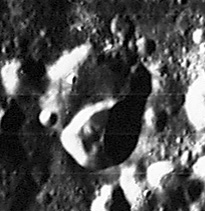Difference between revisions of "Brown"
(Created page with "<div id="content_view" class="wiki" style="display: block"> =Brown= {| class="wiki_table" | Lat: 46.4°S, Long: 17.9°W, Diam: 34 km, Depth: 1.81 km, [/R%C3%BCkl%2064 Rük...") |
|||
| Line 28: | Line 28: | ||
* Kuiper reports in [/PLA%20Table%20III Table III] of his ''[/Photographic%20Lunar%20Atlas Photographic Lunar Atlas]'' (approved by the IAU) that he has modified the IAU boundary of this feature: ''Now applies only to the northern component of the I.A.U. Brown.'' | * Kuiper reports in [/PLA%20Table%20III Table III] of his ''[/Photographic%20Lunar%20Atlas Photographic Lunar Atlas]'' (approved by the IAU) that he has modified the IAU boundary of this feature: ''Now applies only to the northern component of the I.A.U. Brown.'' | ||
* The designation '''Brown E''' for the southern component appears to have been introduced in the ''[/System%20of%20Lunar%20Craters System of Lunar Craters]''. | * The designation '''Brown E''' for the southern component appears to have been introduced in the ''[/System%20of%20Lunar%20Craters System of Lunar Craters]''. | ||
| − | * J. H. Schroter's '''Rob. Smith''' (plate [http://gallica.bnf.fr/ark:/12148/btv1b2600117x.item.f50.langEN T. LV]). A very well defined 72 km crater to the southwest of '''Tycho''', extending from the modern '''[http://the-moon. | + | * J. H. Schroter's '''Rob. Smith''' (plate [http://gallica.bnf.fr/ark:/12148/btv1b2600117x.item.f50.langEN T. LV]). A very well defined 72 km crater to the southwest of '''Tycho''', extending from the modern '''[http://the-moon.us/wiki/Tycho Tycho] D''' to '''Brown D''' and centered at 15.2°W, 45.4°S. It is drawn, but not named, in the [http://the-moon.us/wiki/System%20of%20Lunar%20Craters System of Lunar Craters]. The reference is presumably to [http://en.wikipedia.org/wiki/Robert_Smith_%28mathematician%29 Robert Smith] (1689-1768), author of a famous book on Optics (1738). Research Jim Mosher. |
<br /> | <br /> | ||
==LPOD Articles== | ==LPOD Articles== | ||
Revision as of 20:10, 11 April 2018
Contents
Brown
|
Lat: 46.4°S, Long: 17.9°W, Diam: 34 km, Depth: 1.81 km, [/R%C3%BCkl%2064 Rükl: 64] |
Table of Contents
[#Brown Brown]
[#Brown-Images Images]
[#Brown-Maps Maps]
[#Brown-Description Description]
[#Brown-Description: Wikipedia Description: Wikipedia]
[#Brown-Additional Information Additional Information]
[#Brown-Nomenclature Nomenclature]
[#Brown-LPOD Articles LPOD Articles]
[#Brown-Bibliography Bibliography]
[#Brown-Ernest William Brown in the Sourcebook Project (William R. Corliss) Ernest William Brown in the Sourcebook Project (William R. Corliss)]
[#Brown-Who was Miss Brown? Who was Miss Brown?]

Lunar Orbiter IV Brown is the roughly circular crater at center. The fresher oblong one that overlays it on the south, forming a double crater, is 22 km Brown E.
Images
LPOD Photo Gallery Lunar Orbiter Images
Maps
([/LAC%20zone LAC zone] 111C3) LAC map Geologic map
IAU page: Brown
Description
Description: Wikipedia
Additional Information
Depth data from [/Kurt%20Fisher%20crater%20depths Kurt Fisher database]
- Westfall, 2000: 1.81 km
- Viscardy, 1985: 2.3 km
Nomenclature
- Named for Ernest William Brown (November 29, 1866 – July 22, 1938), an English-born mathematician and astronomer. His life's work was the study and the compilation of extremely accurate tables of the Moon's motion. His mastery of the field was shown by the publication of his first great work, An Introductory Treatise on the Lunar Theory, in 1896. As Brown's work progressed, he gradually evolved a plan to create a completely new [/Lunar%20Theory lunar theory]. This was eventually published as a series of papers in the Memoirs of the Royal Astronomical Society between 1897 and 1908. Brown received the Astronomical Society of the Pacific's 1920 Bruce Medal and extensive links to information about him can be found there.
- This feature is Catalog number 2711 in Mary Blagg's [/Collated%20List Collated List], where it is noted as having been called [/Longomontanus Longomontanus] e in [/Beer%20and%20M%C3%A4dler Beer and Mädler] and in [/Neison%2C%201876 Neison, 1876].
- In [/Blagg%20and%20M%C3%BCller Named Lunar Formations] (1935) the replacement name Brown is attributed to the IAU Commission.
- Kuiper reports in [/PLA%20Table%20III Table III] of his [/Photographic%20Lunar%20Atlas Photographic Lunar Atlas] (approved by the IAU) that he has modified the IAU boundary of this feature: Now applies only to the northern component of the I.A.U. Brown.
- The designation Brown E for the southern component appears to have been introduced in the [/System%20of%20Lunar%20Craters System of Lunar Craters].
- J. H. Schroter's Rob. Smith (plate T. LV). A very well defined 72 km crater to the southwest of Tycho, extending from the modern Tycho D to Brown D and centered at 15.2°W, 45.4°S. It is drawn, but not named, in the System of Lunar Craters. The reference is presumably to Robert Smith (1689-1768), author of a famous book on Optics (1738). Research Jim Mosher.
LPOD Articles
Bibliography
Ernest William Brown in the Sourcebook Project (William R. Corliss)
- In Rare Halos, Mirages, Anomalous Rainbows, and related electromagnetic phenomena (1984) :
- GES1-R18: The Shadow Bands (Ernest William Brown, Journal of the Franklin Institute, 1926). GES1: Solar Eclipse Shadow Bands.
Who was Miss Brown?
T.W.Webb in his Celestial Objects for Common Telescopes (Volume 1; The Solar System) tells us about a certain Miss Brown who seem'd to have been involved in solar sciences. Looks like Miss Brown must have been Elizabeth Brown (1830-1899, British astronomer who specialized in solar observation, especially sunspots and solar eclipses).
- DannyCaes DannyCaes Jul 26, 2015
This page has been edited 1 times. The last modification was made by - tychocrater tychocrater on Jun 13, 2009 3:24 pm - afx3u2